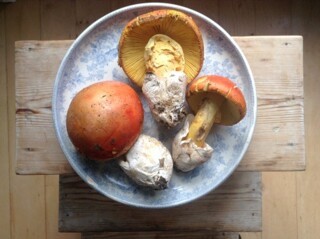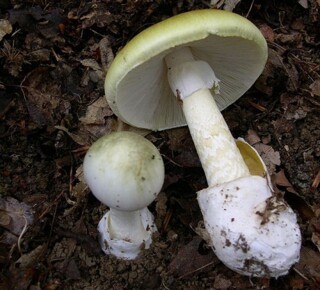Fungal Forays
Inigo Thomas
Amanita caesarea is an edible mushroom that grows around the Mediterranean from late August to October. In France, it’s known as the oronge, in Italy the ovolo. In London, they’re Caesars, or that’s what the greengrocer said when I bought some last week. He’d heard about them for years, but this was the first time he'd seen them at New Covent Garden. There weren't many takers over the next few days, I noticed; orange and yellow, Caesars are beguiling to look at, but that's their problem. Mushroom buyers in Britain tend to like their fungi to look like a suit: neutral.
The Caesar has infamous cousins in the Amanita family; phalloides, verna and virosa, better known as the death cap, the fool’s mushroom and the destroying angel. The death cap has been responsible for more deaths than any other fungus. Agrippina is said to have given her husband, the emperor Claudius, a plate of his much favoured boleti – as Caesars were known to the Romans – interspersed with death caps. There's no firm evidence for it, but food history has always been folklore.
What accounts for Britain's centuries-old mycophobia? Despite Jane Grigson (The Mushroom Feast, 1975) and more recently a River Cottage Handbook on mushrooms, why do most people recoil from Amanita caesarea? Grigson says that hunting for fungi was part of the 'waste nothing philosophy' of French peasants. When Sergei and Varenka go mushroom-picking in Anna Karenina, none of the drama derives from the possibility that they might accidentally poison themselves. But in Britain, the inclination is more to remember the story of the writer Nicholas Evans who mistook some webcaps for ceps in Scotland six years ago, and knocked out his kidneys as well as those of his wife and brother-in-law.
Few varieties of the enormous number of edible fungi are known or eaten here, and most of those are cultivated. ‘There is a deep repugnance for “toadstools” among the people that dwell around the shores of the North Sea,’ Valentina and Gordon Wasson wrote in their two-volume Mushrooms, Russia and History (1957). John Ramsbottom, in Mushrooms and Toadstools (1953), blames the printing press. The often edible mushroom has been traduced into the mainly inedible toadstool, and this has been the way for ages. In The Grete Herball of 1526, fungi have already been divided in two types:
One maner is deedly and sleeth them that eateth of them and be called tode stools, and the other dooth not. They that be not deedly have a grosse gleymymy [slimy] mysture that is dysobedyent to nature and dygestion, and be peryllous and dreadful to eate & therefore it is good to eschew them.
The bad mushroom that appears in many children's books, the archetypal toadstool, whose cap is red and dotted with white pimples, is another member of the Amanita family, the muscaria, otherwise known as the fly agaric. (When added to milk the mushroom is said to kill flies.) It looks deadly, but it isn't. Which isn't to say it isn’t poisonous, only that it isn't death cap or webcap dangerous. The Victorian mycologist M.C. Cooke, whose other books included A Plain and Easy Account of British Fungi, described the experience of eating a fly agaric in The Seven Sisters of Sleep, his ‘popular history of the seven prevailing narcotics of the world’:
The natural inclinations of the individual become stimulated. The dancer executes a pas d’extravagance, the musical indulge in a song, the chatterer divulges all his secrets, the oratorical delivers himself of a philippic, and the mimic indulges in caricature. Erroneous impressions of size and distance are common occurrences... a straw lying in the road becomes a formidable object, to overcome which a leap is taken sufficient to clear a barrel of ale, or the prostrate trunk of an English oak.
The words ‘smut’, ‘punk’, ‘spunk’ and ‘funk’ speak of dirt, danger, sex and anger; they're also the names of certain fungi or of the effects that fungi have had on wood. Another word for them is ‘touchwood’; for centuries they were used as tinder.
Fungi have often been associated with foreignness. Robert Graves would tell the story of a Soho restaurateur called Bozzini who went out to Epping Forest to look for ceps in the autumn of 1940. A policeman keeping an eye out for foreign agents stopped Bozzini and asked what he was doing. The Italian said he was collecting mushrooms. ‘Let’s see them,’ the policeman replied. Bozzini opened his case. Not recognising any of the mushrooms as edible, the policeman arrested him.
Because the law says you can collect wild fungi from parks and public fields, but can’t sell what you find, there’s an element of secrecy about them. Last Sunday, I bought some beef steak fungus at one of London’s farmers markets. Each piece looks a like a steak, especially when it’s been sliced up and you can see the marbled red and white interior. It consumes the heartwood of oak trees. I asked the man selling it where it came from. ‘Essex,’ he said. That was as detailed an answer as I could get.
Ramsbottom ends his book with a chapter about a fungus we have no problem or phobia about; we've taken to it so keenly that its good qualities are wearing thin. That's the fungus called penicillin.


Comments